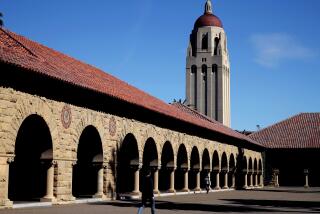Jobs, Rising Tax Revenue Fuel State’s Rebound
- Share via
SACRAMENTO — It was a classic power dinner.
State government’s most powerful Democrat, Senate president pro tem Bill Lockyer, was dining at a small Chinese restaurant with the state’s most powerful Republican, Gov. Pete Wilson. As they sized up one another’s positions on the new state budget, Lockyer decided to play a little parlor game.
Among the questions Lockyer asked: What’s your favorite color and animal? After presiding over the worst recession since the Great Depression, Wilson had little trouble with the color--green, as in money. The animal? Bull, as in bullish on California’s economy.
California indeed is flush once more. And perhaps more than any other economic indicator, the $63-billion state budget that Wilson signed into law last month reflects the new realities. The budget includes $2.6 billion more in tax revenue than Wilson’s experts had anticipated.
“For better or worse, this is a time of fairly broad agreement among California economists. The recovery is for real,” said Stephen Levy of the Palo Alto-based Center for Continuing Study of the California Economy.
“The recovery,” Levy added, “is the first step in California’s emergence as the leader in the 21st century economy. . . . The sectors that have led California back are its long-term growth sectors, and they’re not about to disappear--foreign trade, high-tech exports, entertainment, tourism.”
Examples abound of the turn-around.
Take a page out of Arizona’s state budget. In their 1997 forecast, Arizona budget writers noted that the state had been a beneficiary of California’s woes earlier this decade, with companies relocating there. Now that California is on the mend, there will be a “drop in companies seeking to relocate” to the Grand Canyon state.
Hughes Aircraft was among the California firms that shifted jobs to Arizona during the recession. Hughes’ chief executive gave a parting shot in 1993, saying California “is no longer a competitive place to do business.”
“Realistically, California still is not as competitive,” said Hughes spokesman Richard Dore.
But although the company manufactures missiles and other products in Arizona and elsewhere, Hughes’ “brain power” remains at its research headquarters in Malibu.
And though Hughes’ California work force is 26,000, down from a high of 40,000, the firm has begun hiring at its satellite manufacturing facility in El Segundo. “The talent pool is here,” Dore said.
Of course, recession memories are vivid. Some workers remain displaced. The working poor continue to get squeezed. And companies continue to merge, downsize, restructure and shrink.
But for now, there’s a collective afterglow in the state Capitol. With Republican and Democratic lawmakers in tow, Wilson traversed the state signing the budget and various budget-related bills, trumpeting the new plans for big boosts in education spending and business tax cuts.
The quick explanation for why California is raking in money is that more Californians are working.
Although the Northeast still struggles to recover from the 1990s recession and growth slows in some other regions, California officials proclaimed this spring that job gains in the last two years equaled the hundreds of thousands of jobs lost during the recession. What’s more, the newly burnished Golden State is adding new jobs at a rate of 30,000 a month.
As more Californians get jobs, they pay taxes, and government coffers fatten. The California Taxpayers’ Assn. estimates that state and local government reap $6,000 to $7,000 for each new worker. Although that number is rough, the fact remains that California had $2.6 billion more than expected to dole out in various government programs.
The bulk of California’s $63-billion budget is its so-called general fund, which pays for most state programs. The fund is filled primarily by taxes on income, corporate profits and retail sales. In the 1996-97 fiscal year, the general fund is expected to grow by 6% to $47.6 billion. Most of the new money will go to public schools and a tax cut for businesses.
Here’s a closer look at the rising numbers, and what they say about California’s economy:
* In 1996, jobs are increasing by 2.7% in Northern California and 2.1% in Southern California. But personal income tax collections have risen even more, 8.3% above original projections, to $22.2 billion, state Department of Finance experts say.
One reason for increased income tax revenue flowing into state coffers is that profitable companies gave an unusually large number of bonuses to high-wage executives, and they, in turn, paid hefty sums in taxes on those bonuses, according to California budget writers.
“Companies have been very profitable and executive pay very good--and a lot of that money is subject to [taxation],” said Brad Williams, senior economist in the legislative analyst’s office in Sacramento.
* Another explanation for higher than expected income tax receipts is that the job growth is coming in high-wage fields such as computers and entertainment, which offset losses in the aerospace industry.
Within California’s computer industry, software is now the biggest sector. An estimated 188,000 people work in software, and the field is booming at 20% growth per year, according to the Department of Finance.
Another well-paying field with significant job growth is business services, with 69,700 new jobs or 8% growth in 1996 over 1995. Although the sector includes some low-paying jobs, it also includes the health care industry and firms that employ highly skilled engineers and computer experts.
Still another high-wage industry that’s booming is entertainment. It includes some software designers, particularly in Southern California, as well as multimedia companies.
The motion picture industry itself added 5,400 jobs last year, reflecting growth of 3.3%, the state Employment Development Department reports.
In Southern California, DreamWorks, the partnership of Steven Spielberg, Jeffrey Katzenberg and David Geffen, is building a studio and corporate headquarters on 100 acres near Marina del Rey. In San Francisco Bay, part of Mare Island, a shuttered Navy base, is being used as a movie set.
* A third reason for the increased income tax revenue is that, in general, wages are rising faster than inflation, pushing more workers into higher tax brackets. Overall, income rose 6.4% in 1995, compared to an increase in the main barometer of inflation, the consumer price index, of 2.5%.
Renate MacLaren, 40, and her husband, Tom O’Dell, 36, both benefited from the surge in jobs in California. They moved to Southern California from New Jersey in 1994. O’Dell took a position as an assistant professor at UCLA’s medical school, and MacLaren went to work as a regulatory affairs specialist at Karl Storz Endoscopy, a Culver City maker of medical devices.
MacLaren’s income surged by 20%, and O’Dell’s spiked upward by 50%. ‘Most of the people I know have moved here . . . and made a good salary jump,” MacLaren said. “All came here for better jobs.”
In addition to income taxes, the state’s general fund receives money from taxes on profits of banks and corporations. Revenue from bank and corporate taxes grew 3%, in keeping with the general growth of the economy, to $5.9 billion.
Corporate profits have grown most strongly during the last five years in technology, basic materials manufacturing, cyclical consumer goods and health care industries, according to a Times analysis of data on more than 1,200 publicly held industrial companies in California, gathered by Market Guide Inc., a financial information service firm in Lake Success, N.Y.
Underlying much of the growth is the demand for California products, and the jobs created by California exports have been important in helping lead California out of its deep recession.
The new jobs range from longshoremen positions at the Los Angeles port, now the nation’s largest, to positions at Silicon Valley computer firms, Hollywood studios and Central Valley farms, all of which ship much of what they produce.
California trades as much with the rest of the world as it does with other parts of the country. Exports are up 17% so far this year, after rising 22% in 1995 and 15% in 1994. Japan, the state’s biggest trading partner, accounted for $18.3 billion in trade last year, followed by Canada at $9.5 billion.
The San Francisco region of the U.S. Customs Service reported a 42% increase in exports shipped by air--an indication of the demand for computers and electronic components, because only such high-value goods are moved by jet, said Department of Finance economist Ted Gibson.
In past recoveries, when people went back to work they spent more money on big-ticket items like cars and home appliances. That, in turn, generated sales tax revenues, the second-largest component of the general fund.
For now at least, sales taxes have lagged, growing at about half the rate that sales tax revenue grew when California emerged from the recession of the early 1980s.
One reason for the somewhat limp sales tax revenue is that California’s housing market has not bounced back. Although home prices in the Silicon Valley are rising at 8% a year, many people, especially in Southern California, continue to owe more than their homes are now worth.
In the recovery of 1983, residential building permits doubled from 84,000 to 168,000 in a single year. By contrast, permits to build new homes fell last year, to 86,000 from 96,000 in 1994. With fewer people buying new homes, there is less demand for new washing machines and refrigerators.
Car sales also are not rebounding, perhaps as a result of memories of losing a job or of seeing a friend laid off. People simply may not feel secure enough to go deeply into debt to buy a new car.
“There is still a lot of anxiety,” said Tom Lieser of UCLA’s business forecast. “If it didn’t hit you personally, we all know someone who has lost a job. It has conditioned our behavior and made us pull back.”
The recession hit Lieser personally. He is among the legions who lost their jobs, having been laid off in 1992 when Bank of America bought Security Pacific, where he had been an economist.
“The feeling is very pervasive,” Lieser said. “California has been through a very wrenching change, and Los Angeles most of all. There has been massive restructuring. We’re coming back. But the fact is a lot of people have lost jobs and have had to leave.”
In the coming year or two, California probably will see new layoffs in banking and electrical utilities as banks merge and the utilities undergo deregulation, said Gibson of the Department of Finance.
Other parts of the economy also remain soft. Although Northern California’s office vacancy rates are among the lowest in the nation, Los Angeles’ office vacancy rate remains at 18%, and Orange County is at 14.9%, above the national average of 14%.
Gibson predicts that offices in Orange County and downtown Los Angeles will fill as the recovery continues, but that the Mid-Wilshire district “is not going to recover” any time soon.
“That’s a function of the riot. People don’t want to go back there,” Gibson said.
There are other downsides in this recovery. In many downsized firms, fewer people are producing more, and thus are working longer, economists say.
“It’s like someone turned up the fire under all of us,” Lieser said. “The permanent anxiety level is higher. It’s not in our imagination. There’s not time to make use of [productivity gains] in a personal sense.”
Morain reported from Sacramento and Lee from Los Angeles.
(BEGIN TEXT OF INFOBOX / INFOGRAPHIC)
General Fund Revenues
The state’s general fund revenues are expected to grow sharply in 1996 and 1997 after several years of either flat or falling income.
In millions of dollars
1997: $47,643*
Governor’s estimate
Source: Legislative Analyst’s Office
****
After falling steadily for four years, California employment began to turn up in 1994, the first year of a shaky recovery.
1995: 12,438,158
Source: Employment Development Department
More to Read
Inside the business of entertainment
The Wide Shot brings you news, analysis and insights on everything from streaming wars to production — and what it all means for the future.
You may occasionally receive promotional content from the Los Angeles Times.










